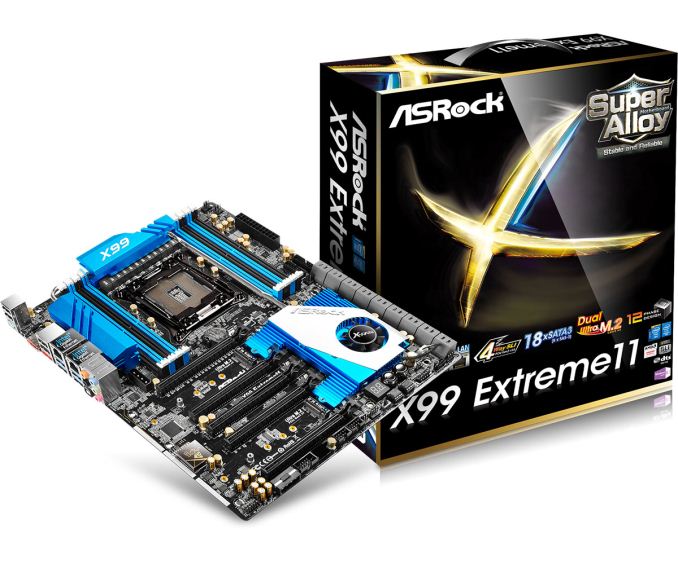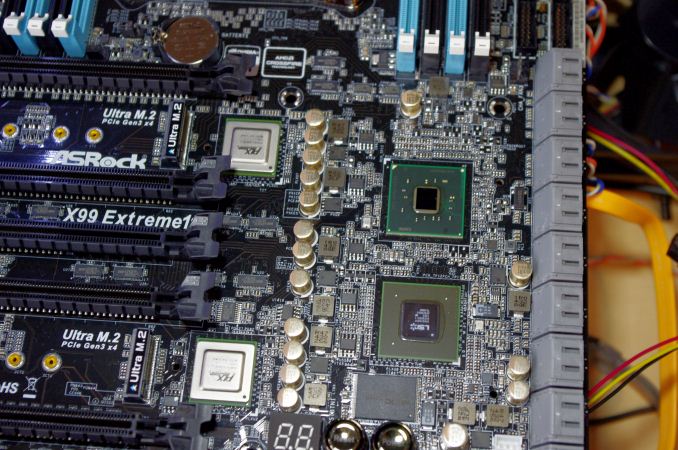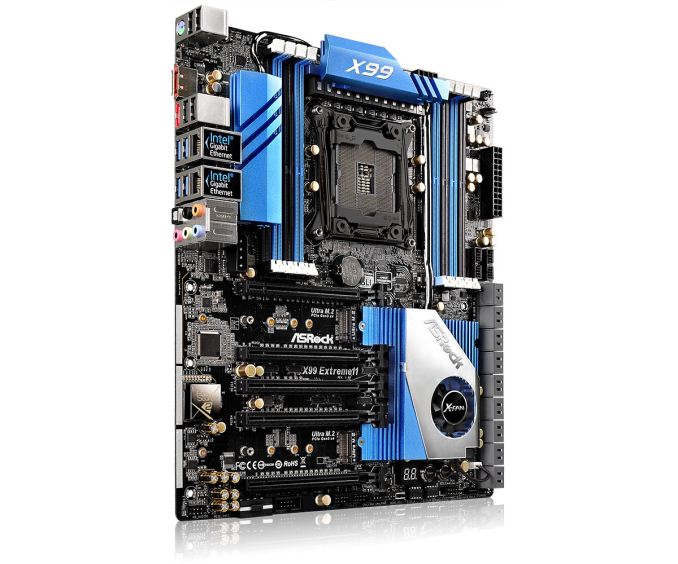The ASRock X99 Extreme11 Review: Eighteen SATA Ports with Haswell-E
by Ian Cutress on March 11, 2015 8:00 AM EST- Posted in
- Motherboards
- Storage
- ASRock
- X99
- LGA2011-3
The ASRock X99 Extreme11 Conclusion
There are particular areas of each electronics market that the general consumer doesn't see or might have difficulty understanding. If a general consumer is concerned primarily about cost, then seeing a market where money-is-no-object offers a strange perspective. Ultimately, the ASRock X99 Extreme11 is in one of these brackets. Most home users would agree that $600+ for a motherboard feels insane, but for the storage and compute markets to which it is focused, $600 can be a drop in the ocean of total system cost. It may even save a few $$$ if it has the required features already onboard.
The reason for the cost of the X99 Extreme11 stems from two PLX8747 PCIe 3.0 switches providing x16/x16/x16/x16 for four-way PCIe coprocessor action as well as an LSI 3008 SAS/SATA controller giving eight more storage ports. These eight ports combine with the ten from the chipset for a total of eighteen.
In the hierarchy of reasons to buy a motherboard, having a particular functionality rates high and it is the functionality that will cause users to buy the Extreme11, similar to the X99 WS-E/10G we reviewed previously. Alongside the to-buy features, the motherboard also comes with dual Intel network ports (I218-V and I211-AT), support for Intel Xeons and 128GB of RDIMMs and a boosted Realtek ALC1150 audio solution in the form of Purity Sound 2.
A key metric in our tests for such a board is power consumption, and given the extra components it perhaps comes as no surprise that under load the Extreme11 draws 244W at CPU load and comes in as nearly the most power hungry out of the X99 boards we have tested. The extra components pushes POST times nearer 25 seconds also. One surprising outcome was the PCH USB 3.0 speed, coming top in our test.
While the Extreme11 is not necessarily bought for performance, the base BIOS we tested with implemented a form of multi-core turbo, giving it high marks across almost all of our CPU suite. Overclocking performance on our mediocre CPU matched that of other X99 motherboards, with the range of automatic options providing suitable feedback to place a manual set of parameters.
In the past, I have always said that the first thing users consider when purchasing a motherboard is if it has a certain feature they need. (Next in the order of narrowing down the options, assuming no prior experience with a brand, is usually price, then looks, then performance, extras and support.) The ASRock X99 Extreme11 sits in that niche for users who want Haswell-E or Xeon E5 v3 as well as storage and multiple PCIe coprocessors - a niche with only few motherboardsin the self-build community, making the Extreme11 a straightforward option.













58 Comments
View All Comments
Stylex - Friday, March 13, 2015 - link
with that logic we should still have usb 1.1 or serial ports. All USB3 just makes things easier to plug in, as you don't have go looking for the 'special' ports.wmaciv01 - Wednesday, March 11, 2015 - link
I just built a system with this board to host my ANS-9010's (x4 32GB in an 8 port RAID 0). Still kind of tinkering with it and exploring the BIOS. I installed the 40 lane 6 core Haswell and have 32GB Mushkin RED DDR4 2400 and a Samsun xp941 256GB as the boot drive. Case is an Xigmatek Elysium. Wish I could post some pics/bench stats for you guys.darkfalz - Thursday, March 12, 2015 - link
8 port RAID 0 - I hope nothing critical resides on that drive.dishayu - Thursday, March 12, 2015 - link
I'm not so sure if I would buy a motherboard without USB-C ports today.darkfalz - Thursday, March 12, 2015 - link
18 SATA ports but no onboard RAID-5 or 6 - almost a LOL moment, but I suppose you could do your boot SSD and then run a huge soft raid array...Navvie - Thursday, March 12, 2015 - link
I'd be interested to see ZFS benchmarks, assuming of course the LSI controller still allows the drives to be accessed as JBOD.mpogr - Thursday, March 12, 2015 - link
It doesn't look like the guys here heard about ZFS, otherwise they wouldn't complain about lack of hardware RAID...mpogr - Thursday, March 12, 2015 - link
This board could be interesting for either a bare metal or virtualised ZFS-based storage server. There is no need in hardware RAID for that one, just fast SATA ports, fast CPU and lots of RAM. Having PCIe 3.0 slots is beneficial for Infiniband cards and, without a switch (which for 40Gbit+ IB costs 1000s), you'd need a few of them, so multiple x8 or slots are beneficial. ECC RAM support (with Xeon CPUs) is a must for such a server as well.What's missing? First and foremost, onboard graphics and IPMI! You want to be able to run this sucker headless. Second, what the heck is with the price? Comparable Supermicro boards (e.g. X10SRH-CF, with IPMI!) cost $400. Yes, they don't support multi-GPU graphics or overclocking, but who needs those on a storage server? I think this board completely missed its target audience...
JohnUSA - Friday, March 13, 2015 - link
$630 ? Ouch, no thanks.mapesdhs - Monday, March 16, 2015 - link
Without any cache, the SAS controller is useless. Lack of cache really kills 4K performance,especially with SSDs (I've tested this with a P410 vs. other cards). With cache included, even
just 1GB, 4K performance can be amazing, over 2GB/sec.
Hence, as others have said, better off using a different cheaper board and a separate SAS card
that does have cache and a BBU, including any numerous X79 boards, though if storage is a
focus then something with 10GigE support makes more sense, XEON, ECC (unless one is using
ZFS I guess), in which case one is moving away from consumer X79/X99 anyway.
mpogr makes some interesting points; thing is, there are proper XEON server boards available
for less anyway, put a SAS card on one of those and away you go, no need to worry about any
consumer-related mbd issues. Afterall, if one is going to be using a XEON and ECC then oc'ing
doesn't matter at all.
I was considering an X79 Extreme11 a couple of years ago for a pro system I was building for
someone (they couldn't afford a dual-XEON setup), but the lack of SAS cache meant it was
not worthwhile. Used an ASUS P9X79 WS instead and I'm glad I did.
Ian.